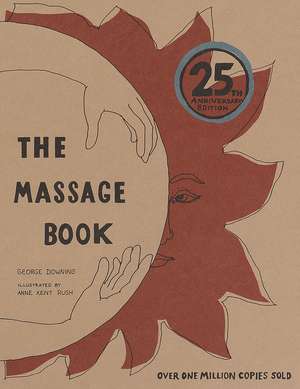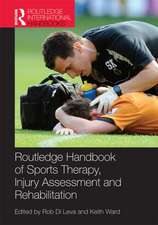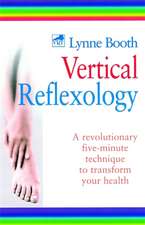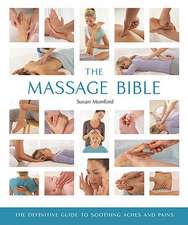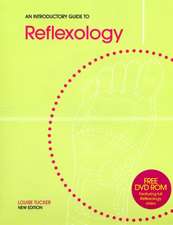The Massage Book: 25th Anniversary Edition
Autor George Downingen Limba Engleză Paperback – 30 noi 1998
Still current and well regarded, The Massage Book was listed by National Health magazine as the first of twenty-five best books that have changed our thinking about our health and our world. Today, as alternative treatments are being discovered by mainstream health plans, massage is still going strong. In the last twenty-five years, countless books on massage have been published, but none rivals The Massage Book.
Preț: 115.91 lei
Nou
Puncte Express: 174
Preț estimativ în valută:
22.18€ • 23.07$ • 18.31£
22.18€ • 23.07$ • 18.31£
Carte disponibilă
Livrare economică 24 martie-07 aprilie
Preluare comenzi: 021 569.72.76
Specificații
ISBN-13: 9780679777892
ISBN-10: 067977789X
Pagini: 192
Ilustrații: B+W LINE DRAWINGS THROUGHOUT,
Dimensiuni: 216 x 278 x 14 mm
Greutate: 0.46 kg
Ediția:Anniversary
Editura: Random House
ISBN-10: 067977789X
Pagini: 192
Ilustrații: B+W LINE DRAWINGS THROUGHOUT,
Dimensiuni: 216 x 278 x 14 mm
Greutate: 0.46 kg
Ediția:Anniversary
Editura: Random House
Extras
How to Use this book
I have written this book with two ends in mind: to tell you how to do massage, and to explain a little of what I see as its meaning and purpose.
The first third of the book contains a lot of practical information which you will want to know before you begin: the nature of massage oils, how to do massage on the floor as opposed to doing it on a massage table and the like. If you have never done massage before, I strongly suggest that you read through these chapters before tackling the later parts of the book. In particular take a good look at "How to Use Your Hands." Even if you already know some massage I would recommend at least a glance at this chapter.
In the middle third of the book you will find instructions on how to give, stroke by stroke and body part by body part, a long and thorough complete massage. The type described is one of many possible variations of what has come to be known as Esalen-style massage. This approach to massage, developed in recent years at Esalen Institute in Big Sur and San Francisco, is in turn a variation of a European tradition over a century old, commonly called Swedish massage. Many of the techniques I teach in my own workshops for Esalen are included in this section.
The type, the illustrations, and the physical design of this book have been planned in order to make it as convenient as possible for you to have it open at your side when you want to try doing some massage with a friend. However, before you start be sure to read over both the short introduction to the instruction section and the particular descriptions of whatever strokes you wish to try out. I would also advise you to start small; don't try to learn more than a half dozen strokes or so at one sitting. Finally, whenever you get a chance, have the strokes you are attempting to learn done to you as well.
Don't worry, incidentally, if as you thumb through this book the strokes in the instruction section look difficult to you. In actual practice they are much easier than they look to be on paper. Numerous people who originally knew no massage have tested portions of this book before it was printed. All found little difficulty in learning the strokes once they actually tried them.
The final third of the book is designed to help you develop your own personal massage style. To this end I have included a series of more advanced technical suggestions, some brief information about other types and traditions of massage, and, most important, some comments about the meaning of massage and how an understanding of this meaning can aid you in doing better work with your hands. Read this part of the book whenever you like, but I suspect that it won't make a great deal of sense until you have become fairly familiar with the material presented in the instruction section. Master a few basic techniques first. Then, with a glance at a few of the guideposts in the last part of this book, by all means go on from there.
I have written this book with two ends in mind: to tell you how to do massage, and to explain a little of what I see as its meaning and purpose.
The first third of the book contains a lot of practical information which you will want to know before you begin: the nature of massage oils, how to do massage on the floor as opposed to doing it on a massage table and the like. If you have never done massage before, I strongly suggest that you read through these chapters before tackling the later parts of the book. In particular take a good look at "How to Use Your Hands." Even if you already know some massage I would recommend at least a glance at this chapter.
In the middle third of the book you will find instructions on how to give, stroke by stroke and body part by body part, a long and thorough complete massage. The type described is one of many possible variations of what has come to be known as Esalen-style massage. This approach to massage, developed in recent years at Esalen Institute in Big Sur and San Francisco, is in turn a variation of a European tradition over a century old, commonly called Swedish massage. Many of the techniques I teach in my own workshops for Esalen are included in this section.
The type, the illustrations, and the physical design of this book have been planned in order to make it as convenient as possible for you to have it open at your side when you want to try doing some massage with a friend. However, before you start be sure to read over both the short introduction to the instruction section and the particular descriptions of whatever strokes you wish to try out. I would also advise you to start small; don't try to learn more than a half dozen strokes or so at one sitting. Finally, whenever you get a chance, have the strokes you are attempting to learn done to you as well.
Don't worry, incidentally, if as you thumb through this book the strokes in the instruction section look difficult to you. In actual practice they are much easier than they look to be on paper. Numerous people who originally knew no massage have tested portions of this book before it was printed. All found little difficulty in learning the strokes once they actually tried them.
The final third of the book is designed to help you develop your own personal massage style. To this end I have included a series of more advanced technical suggestions, some brief information about other types and traditions of massage, and, most important, some comments about the meaning of massage and how an understanding of this meaning can aid you in doing better work with your hands. Read this part of the book whenever you like, but I suspect that it won't make a great deal of sense until you have become fairly familiar with the material presented in the instruction section. Master a few basic techniques first. Then, with a glance at a few of the guideposts in the last part of this book, by all means go on from there.
Recenzii
"This fine book is a classic. No collection of books on bodywork, relaxation or health would be complete without The Massage Book." --Bon Anderson, author of Stretching
"The Massage Book is the best single book on massage ever printed." --Mac Fry, H.H.P., Clinical Director , Mueller College of Holistic Studies, San Diego
"The Massage Book is the best single book on massage ever printed." --Mac Fry, H.H.P., Clinical Director , Mueller College of Holistic Studies, San Diego
Notă biografică
George Downing was a student of body work at the Esalen Institute in California in the early 1970s. He has continued his study of the body and today is one of Europe's most highly regarded teachers on psychosomatic dysfunction.
Descriere
The book that introduced Swedish massage to American culture, "The Massage Book" was listed by "Natural Health" magazine as the third of 25 books that have changed our thinking about our health and our world. Today, as alternative treatments are being covered by mainstream health plans, massage is still going strong. Line drawings throughout.
